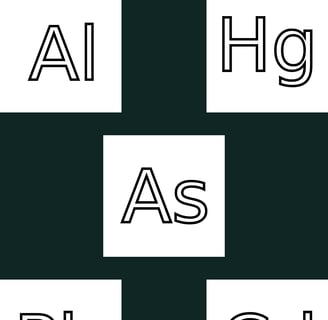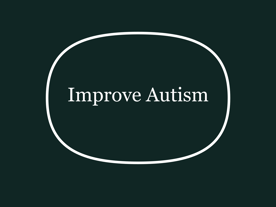Heavy Metals and Autism research
Toxic metals and essential elements in hair and severity of symptoms among children with autism.
Auther:
Blaurock-Busch, E., Omnia, R.A., Dessoki, H.H. and Rabah, T.
Research study
Year
Type
Study size
Abstract
LINK/DOI
Objective: The objective of this study was to assess the levels of ten toxic metals and essential elements in hair samples of children with autism, and to correlate the level of these elements with the severity of autism.
Method: The participants were 44 children, age 3 to 9 years, with Autistic Spectrum Disorder (ASD) according to Diagnostic and Statistical Manual of Mental Disorders 4th Edition, (DSM-IV). The severity of autistic symptomatology was measured by the Childhood Autism Rating Scale (CARS). Hair analysis was performed to evaluate the long term metal exposure and mineral level.
Results: By comparing hair concentration of autistic vs nonautistic children, elevated hair concentrations were noted for aluminum, arsenic, cadmium, mercury, antimony, nickel, lead, and vanadium. Hair levels of calcium, iron, iodine, magnesium, manganese, molybdenum, zinc, and selenium were considered deficient. There was a significant positive correlation between lead & verbal communication (p = 0.020) and general impression (p = 0.008). In addition, there was a significant negative correlation between zinc & fear and nervousness (p = 0.022).
Conclusion: Our data supports the historic evidence that heavy metals play a role in the development of ASD. In combination with an inadequate nutritional status the toxic effect of metals increase along with the severity of symptoms.
44
Observational cross-sectional study
2021
doi:10.3389/fpsyt.2021.742937
Below is a table summarising studies and research on Heavy Metals in the body and Autism - Find the Chelation page for how to treat/clear these.


Heavy metals exposure and risk factors for autism spectrum disorder (ASD) among school children in Makassar City, Indonesia
Authers:
La-Ane, R., Amqam, H., Susilawaty, A., Natsir, M.F., Yusbud, M., Adhariana, H.K. and Aris, A.Z.
Research study
Year
Type
Study size
Abstract
LINK/DOI
60
Cross-sectional study
2025
doi: 10.1016/j.toxrep.2025.102032
This study investigated the associations between heavy metal exposures and autism spectrum disorder (ASD) in school-aged children from Makassar, Indonesia, using an unmatched case-control design with 30 ASD cases and 30 controls without ASD (aged 6–11 years). Hair samples were analyzed by ICP–MS to quantify mercury (Hg), lead (Pb), and cadmium (Cd) levels. Parental questionnaires collected data on potential confounders, including family income, exclusive breastfeeding, family history of ASD, maternal dietary habits, use of skin-whitening creams, and tobacco smoke exposure. Unconditional logistic regression analysis revealed that children with hair Hg levels below 2.0 µg/g had significantly increased odds of ASD (OR = 19.3; 95 % CI: 1.78–533; p = 0.0312), underscoring a strong association between mercury exposure and ASD risk. Conversely, lower hair Pb levels (< 4.5 µg/g) were linked to reduced odds of ASD (OR = 0.164; 95 % CI: 0.0215–0.980; p = 0.0569), suggesting a contradiction potentially mediated by genetic or epigenetic differences in lead metabolism. Additionally, a positive family history of ASD (OR = 24.7; 95 % CI: 2.20–1195; p = 0.0338) emerged as a robust predictor, while maternal use of skin-whitening creams (OR = 0.119; 95 % CI: 0.0121–0.806; p = 0.0409) and the absence of prenatal tobacco smoke exposure (OR = 9.47; 95 % CI: 1.38–193; p = 0.0494) were significantly associated with ASD risk. These findings highlight the multifactorial etiology of ASD and emphasize that both environmental exposures to heavy metals and specific maternal risk factors substantially influence neurodevelopmental outcomes.
Chemicals, Nutrition, and Autism Spectrum Disorder: A Mini-Review
Authors:
Fujiwara, T., Morisaki, N., Honda, Y., Sampei, M. and Tani, Y.
Research study
Year
Type
Study size
LINK/DOI
N/A
Mini-review
2016
doi: 10.3389/fnins.2016.00174
This mini review found the following environmental factors including heavy metals were linked to autism. Below is a very short summary of each of these environmental aspects.
Heavy Metals: Maternal exposure to heavy metals such as lead, mercury, cadmium, and arsenic is associated with an increased risk of ASD.
Micronutrients: Deficiencies in micronutrients like folic acid and vitamin D during pregnancy are linked to a higher risk of ASD in offspring.
Fatty Acids: Higher maternal intake of polyunsaturated fatty acids (PUFAs) during pregnancy is associated with a reduced risk of ASD, while individuals with ASD often have lower levels of omega-3 fatty acids, DHA, and AA.
Smoke/Tobacco: Maternal smoking during pregnancy shows no direct link to ASD after adjusting for socioeconomic factors, though racial differences may exist.
Pesticides: Prenatal exposure to pesticides, particularly organophosphates and organochlorines, is strongly associated with an increased risk of ASD.
Endocrine-Disrupting Chemicals: The connection between endocrine-disrupting chemicals like BPA and phthalates and ASD remains inconsistent, with mixed evidence.
Alcohol: Maternal alcohol consumption during pregnancy is not associated with an increased risk of ASD.
Air Pollution: Exposure to fine particulate matter (PM2.5) during the third trimester of pregnancy is linked to an increased risk of ASD.
Parental Obesity: Both maternal and paternal obesity are linked to an increased risk of ASD in offspring, with paternal obesity showing a stronger association.
Summary of article
Exposure to heavy metals in utero and autism spectrum disorder at age 3: A meta-analysis of two longitudinal cohorts of siblings of children with autism
Author:
Dou, J.F., Schmidt, R.J., Volk, H.E., Nitta, M.M., Feinberg, J.I., Newschaffer, C.J., Croen, L.A., Hertz-Picciotto, I., Fallin, M.D. and Bakulski, K.M
Research study
Year
Type
Study size
Abstract
LINK/DOI
N/A
Mini-review
2016
doi: 10.3389/fnins.2016.00174
Background:
Autism spectrum disorder (ASD) is a prevalent and heterogeneous neurodevelopmental disorder. Risk is attributed to genetic and prenatal environmental factors, though the environmental agents are incompletely characterized.
Methods:
In Early Autism Risk Longitudinal Investigation (EARLI) and Markers of Autism Risk in Babies Learning Early Signs (MARBLES), two pregnancy cohorts of siblings of children with ASD, urinary metals concentrations during two pregnancy time periods (<28 weeks and≥28 weeks of gestation) were measured using inductively coupled plasma mass spectrometry. At age three, clinicians assessed ASD with DSM-5 criteria. In an exposure-wide association frame‑ work, using multivariable log binomial regression, we examined each metal for association with ASD status, adjusting for gestational age at urine sampling, child sex, age at pregnancy, race/ethnicity and education. We meta-analyzed across the two cohorts.
Results:
In EARLI (n=170) 17% of children were diagnosed with ASD, and 44% were classifed as having non-neuro‑ typical development (Non-TD). In MARBLES (n=231), 21% were diagnosed with ASD, and 14% classifed as Non-TD. During the frst and second trimester period (<28 weeks), having cadmium concentration over the level of detection was associated with 1.69 (1.08, 2.64) times higher risk of ASD, and 1.29 (0.95, 1.75)times higher risk of Non-TD. A doubling of frst and second trimester cesium concentration was marginally associated with 1.89 (0.94, 3.80) times higher risk of ASD, and a doubling of third trimester cesium with 1.69 (0.97, 2.95) times higher risk of ASD.
Conclusion:
Exposure in utero to elevated levels of cadmium and cesium, as measured in urine collected dur‑ ing pregnancy, was associated with increased risk of developing ASD. Keywords Metals exposure, Autism spectrum disorder, Pregnancy cohort, Epidemiology, Cadmium, ExWAS
Identifcation of potentially relevant metals for the etiology of autism by using a Bayesian multivariate approach for partially censored values
Authors:
Wegmann, B., Tatemoto, P., Miemczyk, S., Ludvigsson, J. and Guerrero-Bosagna, C.
Research study
Year
Type
Study size
Abstract
LINK/DOI
60
Perspective cohort study
2023
doi: 10.1038/s41598-023-38780-9
Heavy metals are known to be able to cross the placental and blood brain barriers to affect critical neurodevelopmental processes in the fetus. We measured metal levels (Al, Cd, Hg, Li, Pb and Zn) in the cord blood of newborns and in the serum of the same children at 5 years of age, and compared between individuals with or without (controls) autism spectrum disorder (ASD) diagnosis. The samples were from a biobank associated with the All Babies in Southeast Sweden (ABIS) registry. We proposed a Bayesian multivariate log-normal model for partially censored values to identify potentially relevant metals for the etiology of ASD. Our results in cord blood suggest prenatal Al levels could be indicative of later ASD incidence, which could also be related to an increased possibility of a high, potentially toxic, exposure to Al and Li during pregnancy. In addition, a larger possibility of a high, potentially beneficial, exposure to Zn could occur during pregnancy in controls. Finally, we found decisive evidence for an average increase of Hg in 5-year-old ASD children compared to only weak evidence for controls. This is concordant with previous research showing an impaired ability for eliminating Hg in the ASD group.


